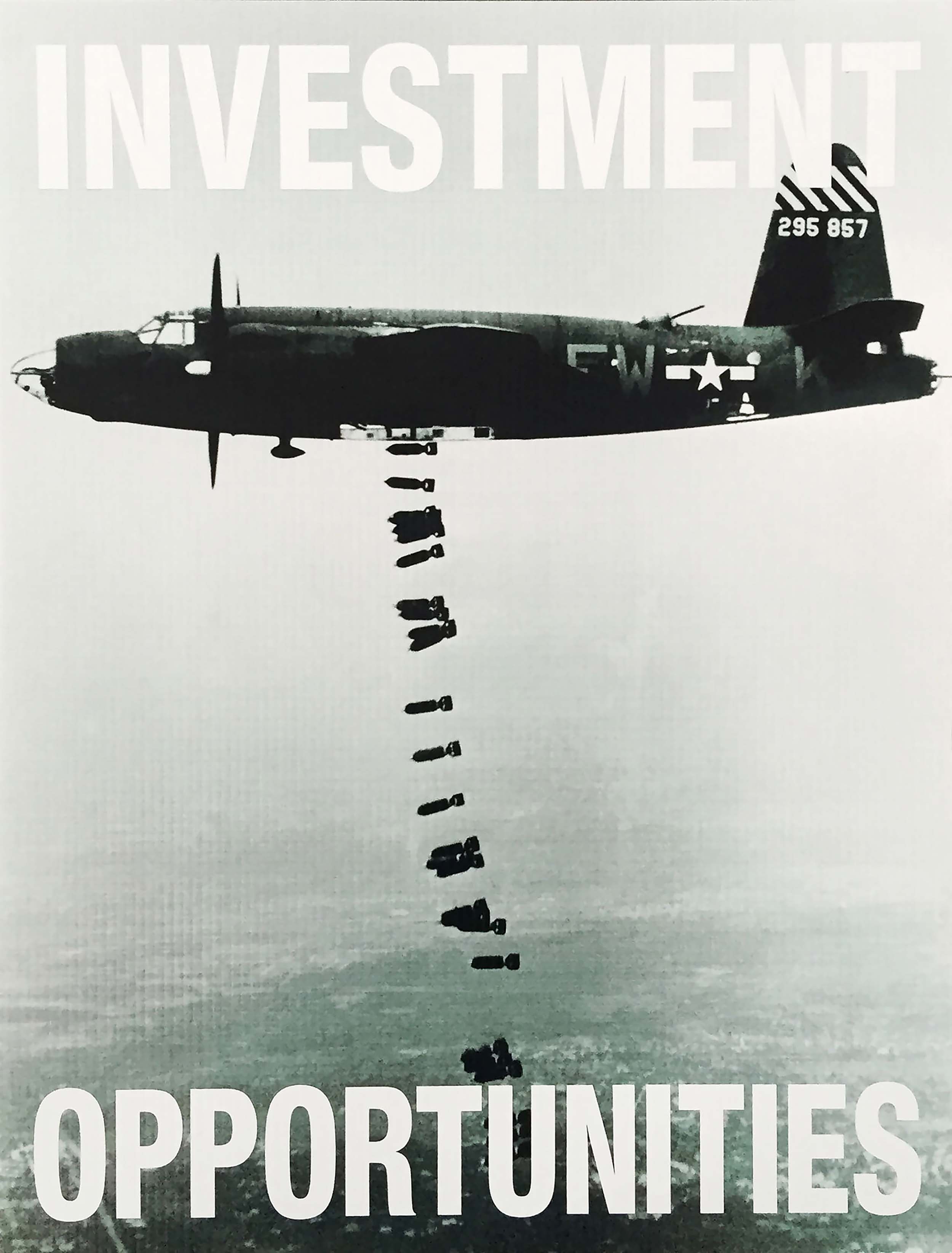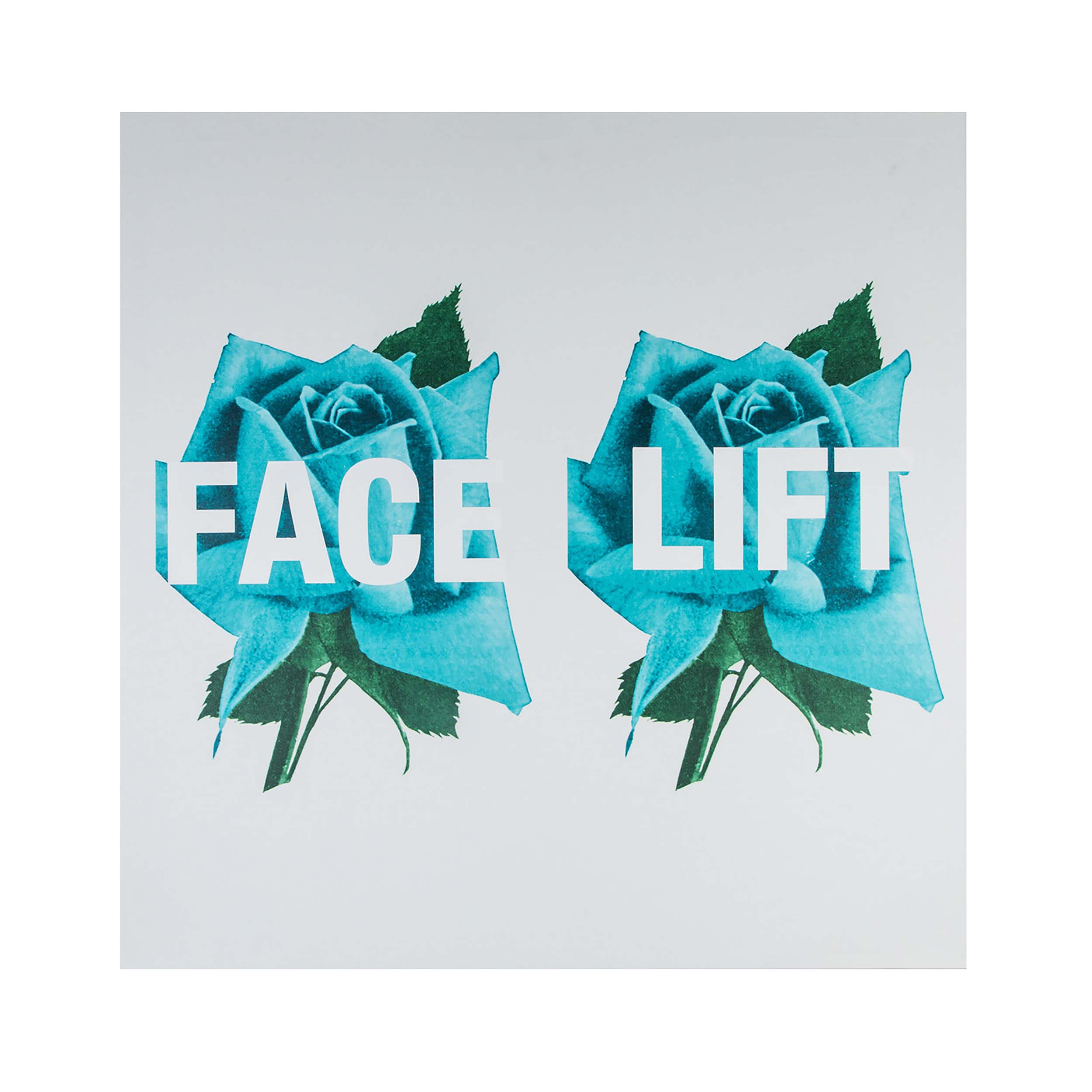bold type
for artist cali thornhill dewitt,
It’s not all bad
Written by Joseph Akel

Cali Thornhill DeWitt More Cost, 2015 Courtesy the artist and V1 Gallery, Copenhagen
If you’re Cali Thornhill DeWitt, the American dream is actually pretty frightening. Over the last decade, the LA-based artist has made a name for himself with text-based works that mordantly juxtapose cutting bon mots with images ranging from funerary floral arrangements to stills from the Trinity Site nuclear test. If Barbara Kruger is the grand dame of a genre that marries readily appropriated cultural imagery with sharp-tongued turns of phrase in hopes of critiquing society, DeWitt is most definitely the family’s black sheep.
Having grown up amidst the thriving punk scene of Southern California, attending shows headlined by the likes of the Cro-Mags, Born Against, and C.O.C., by his teens DeWitt found himself at the gravitational epicenter of the grunge movement. At nineteen, he went on tour with Courtney Love’s band Hole, and shortly thereafter found himself living for a period of time in Seattle, admitted into Kurt Cobain’s inner circle. For those who still have their CD of Nirvana’s album In Utero, that’s DeWitt in full drag.

Cali Thornhill DeWitt Investment Opportunities, 2015 Courtesy the artist and V1 Gallery, Copenhagen
Dewitt ultimately left Seattle and moved back to Los Angeles, where he worked for various music production companies. At the same time, he grappled with drug addiction, at various points entering into rehab and relapsing. “When I was young,” he notes reflectively, “I lived with a very pronounced deathwish.” It wasn’t until he turned twenty-eight that DeWitt committed himself to sobriety, which he has maintained. After sobering up, DeWitt’s creative output greatly increased. He founded the independent record label Teenage Teardrops in 2006, which includes on its roster the likes of No Age, the Sads, and Lucky Dragons. In addition, DeWitt began creating artwork for various album covers and flyers for events, all the while also regularly creating zines and, most recently, producing his large-scale text-based works, such as those exhibited in 2015 at the Copenhagen-based gallery V1. DeWitt’s process for creating the image is, in his own words, “fairly straightforward.” Throughout the day, as word combinations come to mind, he quickly jots them down in the notes folder of his iPhone. Concurrently, he is continually on the lookout for provocative images, readily utilizing Google to aid in his search. Most images that end up in DeWitt’s own pieces are appropriated, including him in a conceptual lineage that includes not only the likes of Richard Prince, but also extends as far back as John Heartfield’s antifascist collages from the mid-1930s.
For DeWitt, there is absolutely a political undercurrent to his work. “My view of Western culture,” he responds when asked about the purpose of his images, “is that it is overly concerned with itself.” His works, he contends, are purposefully critical of society today, but importantly, too, he enjoys the spectacle of the fate we are all careening toward. Indeed, like Nero rejoicing amidst the flames of Rome’s empyreal downfall, DeWitt finds a degree of beauty in the cruelty of it all. “Sure, it’s ridiculous, but I love it.” Several of his more recent works find DeWitt incorporating the American flag. “It’s a sacred image,” DeWitt argues, “and the minute you use it in your art, it becomes provocative.” In one piece, two American flags arranged to form an X are emblazoned in appliqué black letters with the phrase “I EAT OUT OF YOUR GARBAGE CANS.”

Cali Thornhill DeWitt Face Lift, 2015 Courtesy the artist and V1 Gallery, Copenhagen
To be sure, DeWitt’s images are as much an intellectual exercise in capitalist critique as they are upfront gestures at provoking very visceral reactions. In one image, a bullet hole is accompanied by the caption “GLORY HOLE”; in another, a funerary floral wreath is framed by the words “MORE COST.” For DeWitt, the harsh edges and cold truths he articulates hold in themselves terse, if not poetic, import. When asked about his recent incorporation of floral imagery in his works, DeWitt responds meditatively, “I love flowers and how fast they die.”